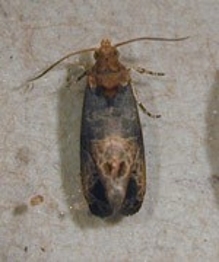Paralobesia viteana (formerly known as Lobesia botrana)
The grape berry moth, a major pest of cultivated grapes, is native to eastern North America. This insect is typically found on wild, native grape species. Its present range of distribution is the territory east of the Rocky Mountains, wherever its wild or cultivated hosts occur. The grape berry moth feeds only on grapes and typically produces 2 generations per year depending on the location.

Life cycle
The adult is a 1/4 inch mottled-brown-colored moth with some bluish-gray on the inner halves of its front wings. The wingspan may be up to ½ inch wide. The larvae of this small moth are active, greenish to purplish caterpillars about 3/8 inch long when fully grown. Grape berry moths overwinter in cocoons within folded leaves in debris on the vineyard floor and within adjacent woodlots. After emerging in the spring, the adults mate and females lay eggs singly on or near flowers or berry clusters. Newly hatched larvae feed upon the flowers and young fruit clusters.
Larvae that hatch in June make up the first generation of grape berry moth and will mature during mid to late-July or August. After mating, females lay eggs on developing berries, and this second generation matures in August or September. Larvae of the second generation, after completing their development, form cocoons in which they overwinter. A third generation occurs commonly in the southern range of the pest and occasionally in the northern tier of states.
Damage
The damage by early first generation larvae can be quite serious since a single larva can destroy potential berries by feeding on buds, flowers, and the newly set fruit. Late first generation and all second-generation larvae feed only on the berries. Often a reddish spot surrounds the point of larval entry. This discoloration can extend over half of the surface of an otherwise green berry. Injured berries ripen prematurely, split open, and shrivel. Webbing produced by the larvae prevent injured berries from dropping to the ground. Larval feeding directly reduces yield and contaminates the crop. The third generation feeds on the leaves, curling them in upon themselves in order to overwinter. More importantly, feeding by grape berry moth larvae creates infection sites for rot organisms and invites attack by Drosophila flies. Infestations by the grape berry moth can vary greatly from year to year and are often very uneven in a vineyard.
Control
In light infestations, injured berries can be removed by hand. Several cultural methods have been used to reduce overwintering grape berry moth populations. A measure of control can be achieved by gathering the leaves with cocoons in the fall and destroying them. Covering leaves containing cocoons under the trellis with at least an inch of compact soil will prevent emergence. This operation must be completed 15 days ahead of the bloom period. Where the grape berry moth is an annual problem, post bloom spraying with insecticides may be necessary if the problem is severe. Remove wild grapes from the adjacent area if possible.
Bacillus Thuringiensis v. aizawai may be used as a biological control and should be applied at egg lay.
Despite good cultural practices, pests and diseases at times may appear. Chemical control should be used only after all other methods have failed.
For pesticide information or other questions please call toll free: 877-486-6271.
Revised by the UConn Home & Garden Education Center, 2016.